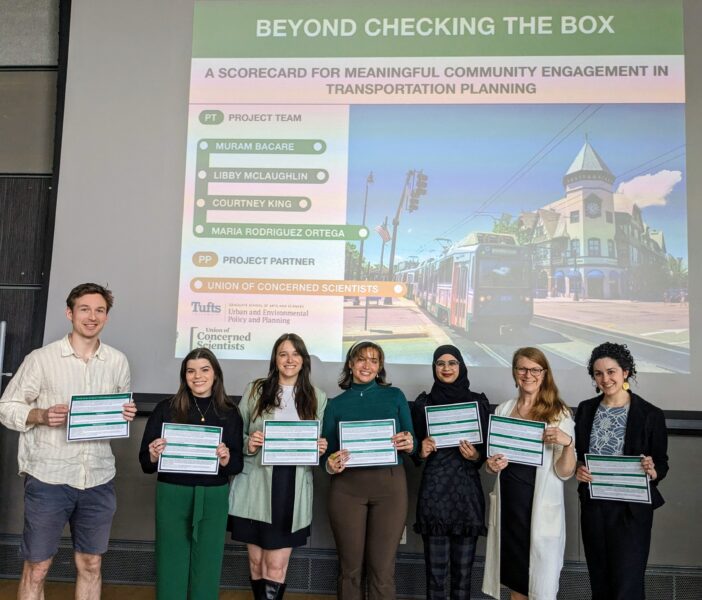What words or feelings immediately come to mind when you think of a public meeting?
If words like long, confusing, or inaccessible rise to the top, you’re not alone. As graduate students pursuing degrees in planning, we’re all too aware of the challenges associated with public engagement processes. Sometimes it can feel like the meeting is simply checking a box, and not truly engaging the community in which the proposed idea or plan is going to impact.
We sought out to really dig into this process in Massachusetts—looking carefully about how the Commonwealth incorporates (or not) meaningful community engagement into transportation planning and policy.
The US Department of Transportation defines meaningful community engagement as, “A process that proactively seeks full representation from the community, considers public comments and feedback, and incorporates that feedback into a project, program, or plan when possible.”
Conducting meaningful community engagement processes within transportation projects and plans is vital for fostering inclusive decisionmaking and promoting connected communities. Environmental justice populations, including low-income communities and communities of color, have been historically excluded from decisionmaking processes, resulting in their needs not being met or prioritized.
With new federal funding opportunities for infrastructure projects, we are in an ideal time for transportation agencies, state Departments of Transportation (DOTs), municipalities, and Metropolitan Planning Organizations to correct historic wrongs and implement more meaningful community engagement practices.
Working with the Union of Concerned Scientists, our goal as a Tufts University Urban and Environmental Planning Field Projects team was to identify best practices for community engagement that can reasonably be applied within Massachusetts transportation planning agencies, and develop a pilot tool that can be used by advocates and agencies to evaluate the impact and equity of current community engagement processes within the Commonwealth.
What did we find?
We identified three major ways to help agencies conduct more meaningful community engagement:
- Move Beyond the Public Meeting: In order to create more meaningful community engagement processes, transportation agencies must move beyond standard public meetings by including alternative opportunities for participation and implementing more participatory formats for collecting community input. Some examples of these strategies include using focus groups or having participants write their ideas on sticky notes to help facilitate conversations. If the meeting is occurring online, online resources such as breakout rooms, surveys, and interactive websites can encourage public participation.
- Create Formal Report-Back Processes: Though the US Department of Transportation considers incorporation of public feedback as one of its key indicators of successful community engagement, there are currently no legal requirements on incorporating and responding to community input collected through these processes. Advocates and Community-Based Organizations (CBOs) voiced that the creation of formal processes to provide more timely feedback that explains how public comments were included in the final designs and plans will result in more meaningful community engagement.
- Evaluate Community Engagement Practices Regularly: Our final scorecard can be used by advocates, community-based organizations, and individuals interested in transportation planning to hold agencies accountable by evaluating their community engagement efforts on how meaningful they are to the communities affected by the plans. Transportation agencies should also use our scorecard to assess their own practices.
Bridging the gap between agencies and communities
Our methods included conducting a comprehensive literature review to identify current requirements and processes used by Massachusetts transportation agencies, collect best practices for meaningful community engagement, select notable recent examples of transportation projects with replicable and effective community engagement processes, and review existing advocacy scorecards.
We also attended a total of seven public meetings held by MassDOT and the Massachusetts Bay Transportation Authority (MBTA) to observe and collect data. For all of the meetings, less than half of the time was dedicated to public comment and only three out of the seven meetings had community groups present at these meetings.
During a MBTA public meeting held on February 27th of this year regarding the Alewife Brook Parkway over MBTA Redline Tunnel Bridge Superstructure Replacement in Cambridge, one public commenter expressed their opinion: “I don’t see any genuine community groups on your list! ASG? Friends of Jerry’s Pond? North Cambridge Stabilization Committee? Please don’t tout ‘outreach to community groups’ when you don’t seem to be able to identify a single one!”
Interestingly, the meeting minutes were not posted following this community engagement event.
Additionally, we conducted interviews with transportation advocates, CBOs, and MassDOT representatives. Their perspectives matched what research has called for decades, such as the need to move beyond the legally required public meetings to methods that are more meaningful and participatory. The need for a report back feature from these agencies was echoed across multiple interview participants.
Another transportation advocate at the meeting said, “Communities are specifically impacted by government action, so they should be updated with respect to how that government action was changed as a result of them speaking out. It would encourage communities to feel more empowered to speak up and submit comments instead of just feeling like it’s going into the black hole of government work.”
New tool created for community engagement
 Second-year students at Tufts University created a tool for community engagement. Left to right: Ian Concannon, Libby McLaughlin, Courtney King, Maria Rodriguez Ortega, Muram Bacare, Professor Kate Davies, UCS Campaign Manager Paulina Muratore. Photo by Courtney King.
Second-year students at Tufts University created a tool for community engagement. Left to right: Ian Concannon, Libby McLaughlin, Courtney King, Maria Rodriguez Ortega, Muram Bacare, Professor Kate Davies, UCS Campaign Manager Paulina Muratore. Photo by Courtney King.Our research culminated in the development of our tool, Checking the Box and Beyond: A Tool for Meaningful Community Engagement, designed for use by CBOs, advocates, and agencies. The tool includes a guiding questions page to assist the user, while the scorecard rates community engagement based on the criteria identified below. The tool ultimately gives the community engagement effort a score from 1 to 5. This tool could also be adapted to meet the needs of other types of planning projects in outside of Massachusetts.
We identified the following categories for evaluation consideration:
- Outreach: Methods intended to notify affected communities of the transportation project as well as opportunities to provide feedback and comments.
- Identification of Affected Communities: The process of determining which communities are most affected by the transportation project.
- Attendance: The public turn-out of the community engagement effort.
- Participation: The level of engagement by the public during community engagement events.
- Care: The treatment of participants during community engagement events. This includes accommodations and incentives such as food, child care, and other forms of compensation to encourage participation.
- Representation: The participation of the impacted communities of the transportation projects. Specifically, assessing whether the impacted communities are meaningfully engaged during the planning process.
- The Use of Technology: The effectiveness of using technology in community engagement processes—social media, online surveys, virtual meetings, and other online tools—to successfully increase public willingness or ability to participate.
- Linguistic Accessibility: Multilingual accommodations, services, and materials provided to community members.
- Physical Accessibility: Physical or geographic traits of the community engagement effort and how they affect community members’ abilities to participate.
- Timing: The stage of the project or plan that community engagement opportunities are held within.
- Frequency of Opportunities: How often community engagement opportunities are held throughout the planning process.
- Transparency of Information to Participants: The availability/accessibility of project information for community members including goals, methods, and processes.
- Variety of Engagement Methods: The diversity of engagement methods used to collect feedback and provide participation opportunities for the community.
- Involvement of CBOs: Involvement of, funding for, and/or reliance on community-based organizations in facilitating the public engagement and outreach processes for transportation planning projects.
- Decisionmaking Power: The involvement of members of the public in decisionmaking bodies, including committee advisory boards, coalitions, or steering and monitoring committees.
- Incorporation of Feedback: The process of using community feedback, values, and goals to inform the direction of the transportation project or plan.
View our full report and get a PDF or GoogleSheets version of the scorecard.

 3 months ago
135
3 months ago
135


